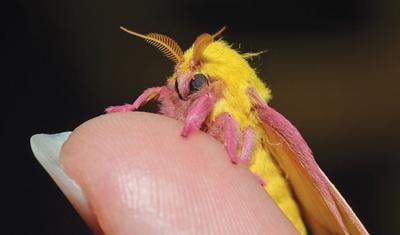By BARBARA MACKAY
The church service was about to begin when some breathless kids pulled me out of my seat to “come see this awesome, pretty, pink-and-yellow, fuzzy baby moth!” on the Sunday school door. It was a rosy maple moth, Dryocampa rubicunda, notable for its dipped-in-sherbet coloring.
The moth’s coloring can vary from pink to purple and from yellow to white. This moth had purplish-pink forewings with a creamy yellow band across the middle. The hindwings were pale yellow with a touch of pink along the edges. Its woolly body was bright yellow above and raspberry pink below. The legs were the same pink, much to the surprise and delight of the kids. The head looked like a yellow craft pompom. With wings spread wide, the moth was just over an inch across and just under an inch long.
As I coaxed it from the door handle to my finger, it spread its wings for a brief photo op, but then it seemed to die on the spot. Everyone gasped in shock as I placed it in a nearby bush, where it swung upside down, clinging to a leaf stem. Witness a nifty self-defense strategy: curling up deathlike on one’s side with wings folded in.
Because the moth stayed still for several moments (it is at its most sluggish on cool mornings), we were able to observe its antennae, which were bright pink and feathery. Female antennae have a simple feather-like arrangement, while the male has a more complex structure. Our moth appeared to be a female, which may signify a need for increased observation of the nearby maples during the next few weeks: Rosy maple moth adults may be darling, but their larvae can be destructive.
Rosy maple moth mating usually takes place in the evening. If it is successful, a female lays up to 200 eggs of ten to thirty on the undersides of the leaves of a host tree – typically silver, red, and sugar maples – the next night.
Two weeks later, the tiny yellow eggs hatch. At first, the caterpillars stay together and feed voraciously, eating their way from the leaf margin where they were born to the midvein of a leaf, before moving on to the next. The caterpillars are pale yellow-green, with green stripes running the length of their body. Two rows of short black spikes grow out of each segment. The second segment has two long black horns. Two long black filaments protrude from the back of the head. There is a small pink marking near the rear of an immature larva.
The caterpillar goes through three instars – or molting stages – and as it grows these pink markings change to deep-red. The head changes from black to brown to red. The final molt results in a thick-skinned caterpillar that is almost two inches long and is a darker, greenish brown than was its pale, younger self.
Month-old caterpillars move to the ground. They burrow just below the soil’s surface underneath the host tree, creating chambers in which to pupate and spend the winter. The pupae are dark brown, with the segments of the caterpillar stage still visible. Protected by insulating snowfalls, pupae survive cold winter winds and temperatures. The adults emerge the following spring. In the Northeast, they fly from May to August, reproducing only once.
Like many moths, rosy maples are attracted to lights at night. You can increase your chance of seeing this beautifully pigmented insect if you have maple trees and a porch light.
Barbara Mackay is a teacher and naturalist who lives in northern Vermont. The Outside Story is assigned and edited by Northern Woodlands magazine, and sponsored by the Wellborn Ecology Fund of the New Hampshire Charitable Foundation.














(0) comments
Welcome to the discussion.
Log In
Keep it clean. Please avoid obscene, vulgar, lewd, racist or sexual language.
PLEASE TURN OFF YOUR CAPS LOCK.
Don't threaten. Threats of harming another person will not be tolerated.
Be truthful. Don't knowingly lie about anyone or anything.
Be nice. No racism, sexism or any sort of -ism that is degrading to another person.
Be proactive. Use the "Report" link on each comment to let us know of abusive posts.
Share with us. We'd love to hear eyewitness accounts, the history behind an article.